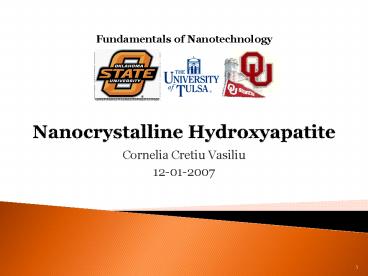Nanocrystalline Hydroxyapatite
1 / 14
Title: Nanocrystalline Hydroxyapatite
1
Nanocrystalline Hydroxyapatite
Fundamentals of Nanotechnology
- Cornelia Cretiu Vasiliu
- 12-01-2007
2
Outline
- Motivation
- Methods of synthesis
- Characterization of structure
- Morphology and particle size
distribution
- Properties
Applications
3
Why nano-Hydroxyapatite (nHA)
- Bone 2nd most implanted tissue after blood
- Protein matrix containing type 1 collagen and
minerals - Calcium as
- (Ca 2)10-x(H3O)2x(PO
4)6(OH-)2 - Synthetic vs. homo-, allo-, xeno-geneic implants
- Properties biocompatibility,
biodegradability, mechanical integrity,
vascularization inductivity, osteoconductivity,
and osteoinductivity
http//www.uabhealth.org/16313
4
Methods of synthesis
HA Wet methods5 Solid-state
reactions6 Sol-gel7 Ellectrocrystallization8 Spray
pyrolysis9 Emulsion processing10 Hydrothermal
treatment11
nHA Chemical
precipitation1 Hydrothermal treatment12 Microwave
synthesis2
To be considered stoichiometry,
pH, rate of addition, ionic strength
5
nHA Methods of synthesis
- Co precipitation
1) - Ca(OH)2 H3 PO4 nHA
- Aqueous, pH 8, 38oC
- Microwave synthesis 2)
- 10 Ca(OH)26 (NH4)2HPO4
Ca10(PO4)6(OH)26H2O12NH4OH - 850W, 20 min.
- 13)Aq. Sol. NaNO3, Ca(NO3)24H2O and KH2PO4
precursor - 600W, 5 min.
- stirred in H2O ( room temperature , 1 h) nHA
particles.
6
Structure characterization
- XRD(1
Powder XRD of the HA precipitate (a)
as-prepared, (b) calcined at 700 C, (c) calcined
at 800 C, (d) calcined at 900 C and (e)
calcined at 1200 C. specific peaks (H) HAP
(b) ß-TCP (a) a-TCP.( 1
7
Structure characterization (2)
- IR(1 spectra of the nHA precipitates
- (a) as-dried,
- (b) calcined at 700 C,
- (c) calcined at 800 C,
- (d) calcined at 900 C and
- (e) calcined at 1200 C.
8
Particles morphology
SEM micrograph of the as-prepared nHA(1
TEM micrograph of as-synthesized nano HA
crystals(14
9
Particle size distribution
- DLS Histogram representation of the mean
diameters of as-prepared nHA suspended in aqueous
solution. (1
10
Applications
Coatings
- Cell morphology after being cultured for 15 min
on the different nHA coated(G2) and uncoated(G1H)
titanium surfaces. - Surface roughness decreased(2
(2
Fibers, tubes
- nHA doped PLGA composite (30 nHA) hollow fiber
membrane fabricated using wet phase inversion
technique (13
(13
11
Applications
- Bone filler(4
- Preoperative axial CT
- (B) Lateral preoperative view
- (C) After reduction, the remaining defect was
filled with nHA paste. - (D) Postoperative radiograph
- (E) 6 weeks after surgery . The patient
progressed to full weight bearing at this point
in time. - (F) 12 months postoperatively, only a marginal
loss of correction could be measured.
12
Future developments
CT scan
Computer file
Choose customized design
Print, sinter implant
Seed cells, growth factors
Implant
13
References
- http//www.sciencedirect.com/science/article/B6THV
-4JVK567-1/2/501b2d84c7d81d8e9dc5771941065db1
Phase - Xiaolong Zhu et al 2006 Nanotechnology 17
2711-2721 - http//www.sciencedirect.com/science/article/B6TWH
-4KY88TT-3/2/2a01537a8d0b528852bb67f079d7e91a
Rapid densification - F. Huber, J. Hillmeier, N. McArthur, H. Kock and
P. J. Meeder, The Use of Nanocrystalline
Hydroxyapatite for the Reconstruction of
Calcaneal Fractures Preliminary Results, J. of
Foot and Ankle Surgery Vol. 45/ 5, 2006, pp.
322-328. - C. Liu, Y. Huang, W. Shen and J. Cui,
Biomaterials 22 (2001), pp. 301306. - X. Yang and Z. Wang, J. Mater. Chem. 8 (1998),
pp. 22332237 - W. Feng, L. Mu-sen, L. Yu-peng and Q. Yong-xin,
Mater. Lett. 59 (2005), pp. 916919 - S.K. Yen and C.M. Lin, Mater. Chem. Phys. 77
(2003), pp. 7076. - K. Itatani, T. Nishioka, S. Seike, F.S. Howell,
A. Kishioka and M. Kinoshita, J. Am. Ceram. Soc.
77 (1994), pp. 801805 - C.-W. Chen, R.E. Riman, K.S. TenHuisen and K.
Brown, J. Cryst. Growth 270 (2004), pp. 615623 - G.Z. Hui, Z. Qingshan and H.X. Zhao, Mater. Res.
Bull. 40 (2005) (8), pp. 13261334. - W.L. Suchanek, K. Byrappa, P. Shuk, R.E. Riman,
V.F. Janas and K.S. TenHuisen, J. Solid State
Chem. 177 (2004), pp. 793799 - N. Zhang et al. / Materials Science and
Engineering C 27 (2007) 599606 - S. Ramesh et al. / Ceramics International 33
(2007) 13631367
14
Questions?
HAßTCP 6040 1100oC/4h
HAßTCP 6040 1270oC/4h

